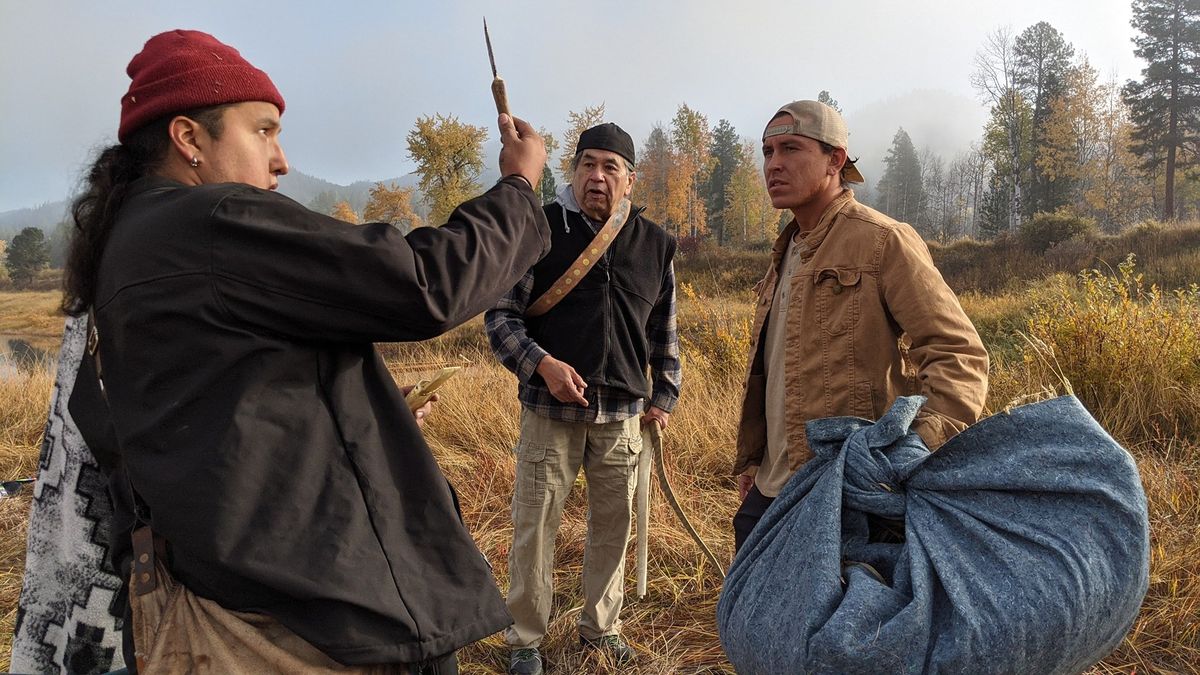Supernatural thriller short-film ‘Strongest at the End of the World’ showcases Salish language

Written entirely in Salish, filmmaker Ryan Abrahamson’s latest work is an audio-video echo of the past. Loosely based on the legend of Devil’s Gap, the story came to Abrahamson like a poem.
“Strongest at the End of the World” follows Qemtsna (Tanajsia Slaughter) and Xwistu (Shane DuBray), a young Native American couple celebrating their honeymoon, 100 years before the first settlers visited the Inland Northwest. Wading through a waterhole one day, the couple stumble across a glowing rock imbued with medicine – that is, a certain power to bring about “unseen change.”
Xwistu (pronounced “Whees-stoo”), a fisherman who longs for the strength of a bear and the ability to provide for his family, uses the rock to search for hunting spots. But as time passes and Xwistu continues longing for more, Qemtsna (Kemt-sheh-nah), content with what they already had, struggles to bring him back to his senses. But in the end, her efforts may prove too late.
“When I originally wrote the film, it was on two sheets of Xerox,” he said. “Just a series of one line stanzas.”
Abrahamson’s team at Counting Coup Media secured a Spokane Arts grant in 2020.
Years later, knee-deep in post-production, Abrahamson and his team are still working on special effects, sound and music. But they expect to have a screenable film sometime this winter.
A Spokane Tribe member, Abrahamson wanted to ensure the casting was representative of his culture.
“We got a lot of people who were super gung ho and nice … but weren’t Indian,” Abrahamson said. “It said clearly in the casting call, you know, ‘Must be Native American or nonwhite.’ ”
With a little extra time, they eventually they found their leads. Then it was just a question of diving headfirst into Salish.
He knew committing to the Salish dialogue would pose certain difficulties.
“Salish is a very unique language as far as human speech pattern – virtually no vowels, almost all consonants – it’s almost constantly asking you to close your mouth or click your tongue, or produce phlegm,” Abrahamson said. “It was tough just to get people to say a word correctly.”
Between pronunciation and comprehension, learning the dialogue took the actors nearly two months.
“What it directly translates to, is closer to Shakespearean English than it is to modern English,” he said. For example, in Salish, instead of “I went to open the doors,” you might say “the door opened as he went to it.”
As difficult as it was, the joy of hearing Salish spoken was enough of a reason to continue. During filming – which took place exclusively on the Spokane and Kalispel reservations – tribal elders would visit to watch the actors rehearse, just to hear the words.
“I want to keep Salish in films as much as possible,” Abrahamson said.
“We want to create films that have to do more with the cultural identity of being a Native American or American Indian,” he added. That means not just making films about their relationship with American pioneers, but also “African, English, French, Asian, Russian … all these in the Pacific Northwest. There’s a weird treasure trove of how many explorers came to this region.
“That’s something that we really are wanting to talk about – how actually inclusive the Wild West was,” he said. “And there’s all kinds of ways we want to showcase that.”
Abrahamson hopes Salish might be taught in local public schools as an elective one day.
After all, he said, “Salish has been spoken in this region for longer than English or Spanish.”
For information, visit countingcoupmedia.com.